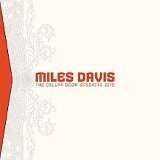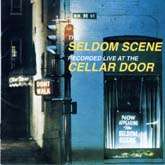The Cellar Door
The Cellar Door was a 163-seat music club at 34th and M Street NW in Washington, D.C. from 1964 [1] through 1981. It occupied the location of a former music club called The Shadows. It was one of the premier music spots in Washington and was the genesis as well as a tryout for larger markets.[2] Many artists cut their professional teeth performing at the Cellar Door, while audiences delighted in being within a few feet of the stage at the tiny venue. Many notables in 1960s and '70s music played there.[3][4] Some of the performances at The Cellar Door were recorded and released. The Bud & Travis In Person album was recorded there in 1964. The club was the 1970 venue for the renowned Live-Evil (later expanded into The Cellar Door Sessions), a live album with Miles Davis.[5][6] Richie Havens recorded most of the tracks on Richie Havens Live at the Cellar Door there in 1970 and The Seldom Scene, a Bethesda, MD based bluegrass band, recorded their signature live album Seldom Scene Recorded Live At the Cellar Door in December 1974. Danny Gatton's The Redneck Jazz Explosion album was also recorded at The Cellar Door in 1978.


In 2013, Neil Young released an archival concert album from a six-show solo stand at the Georgetown nightclub in late November and early December 1970 entitled Live at the Cellar Door[7]
Notable artists
Some of the names that played there during their careers were:
- John Abercrombie
- America in their first American appearance
- Joan Armatrading
- Artful Dodger
- Jackson Browne[8]
- Brewer and Shipley
- Brecker Brothers
- Aztec Two-Step
- Bud & Travis
- Allen Collins Band 1983
- Jimmy Buffett
- JJ Cale
- George Carlin (Critically acclaimed FM & AM, won the 1972 Grammy Award for Best Comedy Album, was based on live recordings made June 25–26, 1971, at the Cellar Door, Washington D.C.)[9][10]
- Harry Chapin
- Cheech and Chong
- Larry Coryell
- Bill Cosby (warm-up comic for the Mitchell Trio with John Denver)
- The Country Gentlemen
- Jim Croce
- Miles Davis[6] (whose concerts there were the basis for the critically acclaimed Live-Evil, later expanded into a box set comprising the entire unedited performances "The Cellar Door Sessions")
- John Denver[8] (He sang his "Leaving, On A Jet Plane" there prior to being released by Peter, Paul and Mary. "Take Me Home, Country Roads" was sung for the general public for the first time anywhere at the club on December 30, 1970.)
- The Dillards
- Fat City (later to become the Starland Vocal Band)[11]
- Doc and Merle Watson
- Gabe Kaplan
- Neil Sedaka
- John Fahey
- John Hammond
- David Mallett
- The Flying Burrito Brothers
- The Newgrass Revival
- Paul Siebel
- Danny Gatton
- Steve Goodman[11]
- Great Speckled Bird (Ian & Sylvia)
- Happy The Man
- Richie Havens
- Rick Nelson
- Pete Kennedy[6]
- B.B. King
- Carole King
- Donal Leace
- Ramsey Lewis Trio
- Gordon Lightfoot
- Ian & Sylvia
- Les McCann
- Roger McGuinn
- Charlie Mingus
- Chad Mitchell Trio
- Judy Collins
- Joni Mitchell
- Modern Jazz Quartet
- Anne Murray[12]
- Rick Nelson
- Gram Parsons performed with a backing band at the Cellar Door, while looking for a female vocalist for duets. His bandmates had visited a small neighboring bar where Emmylou Harris was performing cover songs, and their introduction was the real start of Harris' career, and a boost for Parsons' act.
- Les Paul
- Minnie Riperton
- Lee Ritenour
- Linda Ronstadt
- Carly Simon
- Tom Paxton
- Pointer Sisters[13]
- Tom Principato[6]
- John Prine[14]
- Richard Pryor [8]
- Bonnie Raitt in 1969.[14]
- Linda Ronstadt[8] (her band was made up of later members of The Eagles)
- Buddy Rich
- Chris Rush[11]
- Tom Rush
- John Sebastian
- Shakti w/ John McLaughlin[15][16]
- Patti Smith
- Tommy Smothers
- David Steinberg
- The Stone Poneys
- Taj Mahal[11]
- James Taylor [8]
- Livingston Taylor
- Nighthawks Jimmy Thackery [17]
- George Thorogood [17]
- Mary Travers
- Muddy Waters
- Tom Waits
- Glenn Yarbrough[11]
- Neil Young[8][18]
- Brand X
- Warren Zevon
Some music was written on site. Bill Danoff and Taffy Nivert (as Fat City) opened for John Denver in December 1970. Late one night, Denver helped finish writing a song that Danoff and Nivert had started. They debuted "Take Me Home, Country Roads" on December 30, 1970.[19][19]
In a January 31, 1981 Washington Post newspaper article, Richard Harrington [8] wrote that the Georgetown club which helped promote the careers such stars as Linda Ronstadt, James Taylor, John Denver, Richard Pryor, Neil Young and Jackson Browne, was sold the previous day for an undisclosed sum to Paul Kurtz and Howard Bomstein from Washington, D.C. Ultimately, the club was closed down by the DC fire marshal after numerous warnings. It had been licensed for 163 seats, but was found to have more than 200 people SRO at times. Also, the books for liquor sales were allegedly being done improperly, so instead of making money, a fair amount of money was being lost, unbeknownst to the club owners.
Cellar Door Productions
The Cellar Door Nightclub was a partnership between Jack Boyle and Sam L'Hommedieu, Jr. The pair also owned two other popular Georgetown nightspots, The Crazy Horse and The Bayou, as well as The Stardust, a music club in Waldorf, MD. They went on to found Cellar Door Productions which became the largest concert promoter from Baltimore to Florida, with offices in Washington DC, Ft. Lauderdale FL, Myrtle Beach, SC as well as an office in Detroit for a period of time. Bill Reid was the President of Cellar Door Productions from 1983 until his firing in 1997.[20] The Cellar Door Cos. were sold to SFX Entertainment in 1999.[21] Cellar Door developed the Nissan Pavilion concert venue,[3] now called the Jiffy Lube Live, west of Washington, DC.[3] The mailing address of Jiffy Lube Live (now owned by Live Nation) is 7800 Cellar Door Drive.
Boyle continued with SFX after it was purchased by Clear Channel Entertainment and is now retired. L'Hommedieu managed the Warner Theatre (Washington, D.C.) during the 1980s. He died in 1999, and is buried in Arlington Cemetery.[22]
Building
The building where the Cellar Door operated was vacant for many years, hosting the Philadelphia Cheesesteak Factory until May 2009 and Capriotti's sandwich shop in 2014.[23] In the June 7, 2018, issue of The Georgetowner, Robert Devany's Ins & Outs article reported that Starbucks would occupy the vacant 2,600-square-foot space most recently a Capriotti’s Sandwich Shop, that lasted only a year. Its most famous iteration, from the 1960s to the 1980s, was as the legendary music venue.[24] Alec Berkman, BISNOW National contributor reported in July 17, 2017 that before its summer break, in June, the Georgetown-Burleith Advisory Neighborhood Commission approved design plans for the Starbuck store. The commission was initially opposed to Starbucks’ signage. However, the opposition was reversed when it was learned that Starbucks corporate gave a commitment to honor the Cellar Door by exhibiting photos of the many entertainment acts that appeared at the venue over its years of operation at the historic location.[25]
References
- "Clinking glass and swinging sound change the image of Georgetown". The New York Times. May 25, 1964.
- Weintraub, B. (1976, November 20). Concert market booming in D.C. Billboard Magazine, 88(47)
- "PAGE THREE The MetropoList". Washington Post. Retrieved 2014-03-14.
- "Live Online". Washington Post. 1998-12-04. Retrieved 2014-03-14.
- "Miles Davis: The Cellar Door Sessions 1970". Allaboutjazz.com. Retrieved 2014-03-14.
- Harrington, R. (2003, November 21). Recordings deliver taped measure of area clubs. The Washington Post, p. T.34.
- McKenna, Dave (9 December 2013). "Neil Young's 'Live at the Cellar Door' is a window into D.C.'s musical past". Washington Post. Retrieved 29 December 2015.
- Harrington, R. (1981, January 31) 2 From D.C. Buy The Cellar Door, Style Section. Washington Post, p. G4.
- The Cellar Door at AllMusic
- "George Carlin - Official Website". Archived from the original on 2014-02-07.
- (1973, July 14) Who/When/Where (concert listings). Billboard Magazine, p. 17. Accessed 2010-01-11.
- (1973, July 14) From the Music Capitals of the World. Billboard Magazine, p. 57. Accessed 2012-09-15.
- Pointer Sisters. (1973, June 30) Pointer Sisters tour dates. Billboard Magazine, p.36.
- Harrington, R. (1989, June 13) Bonnie Raitt, Dry and High; The Singer's Long Road to Sobriety and a Hit Album. Washington Post, p. c.01.
- "Shakti w/ John McLaughlin....November 12, 1977 (First Show) (9PM) : The Cellar Door, Washington, D.C., U.S.A." Tela.sugarmegs.org. Retrieved 2015-10-26.
- "Shakti with John McLaughlin - Live at The Cellar Door, Washington, D.C., U.S.A., November 12, 1977 [REMASTER][FLAC] | Dr. Fusion". Drfusion.blogspot.com. 2009-11-28. Retrieved 2015-10-26.
- Alpert, B. (1993, May 15). M Street Shuffle. Washington Post, p. A23
- (1970, November 21). From the music capitals of the world. Billboard Magazine, 82(47), p. 27
- "Bill & John Denver". Billdanoff.com. Retrieved 2014-03-14.
- "A. William Reid v. John J. Boyle, Cellar Door Venues, Inc" (PDF). Bischoffmartingayle.com. Retrieved 2014-03-14.
- "The Dream Home That Never Was". Washingtonpost.com. 2007-08-04. Retrieved 2014-03-14.
- Michael Robert Patterson. "Samuel J. L'Hommedieu, Jr., Sergeant, United States Army". Arlingtoncemetery.net. Retrieved 2014-03-14.
- Cooper, Rebecca (30 July 2014). "Love 'n Faith brings liquid nitrogen ice cream to Columbia Heights; Capriotti's heads to Georgetown". Retrieved 29 December 2015.
- Devaney, Robert (7 June 2018). "The Georgetowner; Ins & Outs; In:Where Cellar Door Was - Starbucks No. 5". Retrieved 9 September 2018.
- Berkman, Alec (17 July 2017). "BISNOW; New Kids On The Block: Georgetown". Retrieved 9 September 2018.